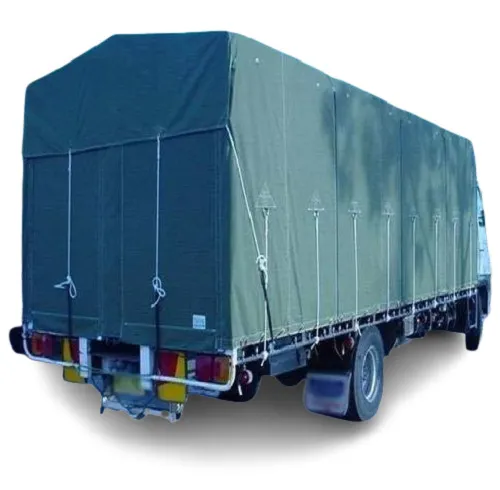In the dynamic world of logistics and transportation, truck tarpaulins play a vital role in protecting cargo from the elements, ensuring safe delivery from origin to destination. However, exposure to harsh weather conditions, frequent use, and improper handling can significantly shorten their lifespan. To maximize your investment and minimize operational costs, understanding how to prolong the lifespan of truck tarpaulins is crucial. This comprehensive guide outlines practical strategies that actively contribute to their longevity, enhancing both efficiency and profitability.

I. Selecting the Right Material: A Solid Foundation
1. Durability-focused Choice:
Opt for tarpaulins made from high-density polyethylene (HDPE) or polyvinyl chloride (PVC) coated fabrics. These materials offer exceptional resistance to tearing, abrasion, and UV radiation, making them ideal for prolonged outdoor use.
2. Waterproofing & Breathability:
Ensure your tarpaulin is fully waterproof to prevent moisture damage to cargo. At the same time, look for breathable fabrics that allow air circulation, reducing condensation and mold growth.
3. Color Matters:
Darker colors absorb more heat, potentially accelerating material degradation. Lighter shades, especially silver or reflective ones, reflect sunlight, helping maintain a cooler temperature underneath and prolonging the tarp’s life.
II. Proper Storage & Handling: A Gentle Touch
1. Cleanliness is Key:
Regularly clean your tarpaulins with mild soap and water, avoiding harsh chemicals that may damage the fabric. Allow them to dry completely before storage to prevent mildew.
2. Fold Wisely:
When storing, fold the tarpaulin neatly, avoiding sharp creases that can weaken the material over time. Use fold lines marked by the manufacturer, if available, for optimal storage.
3. Store in a Dry Place:
Keep tarpaulins in a cool, dry environment, protected from direct sunlight and extreme temperatures. This minimizes exposure to UV rays and prevents moisture buildup.
III. Regular Maintenance & Inspection: Prevention is Better Than Cure
1. Inspect Before Each Use:
Before covering your truck or cargo, inspect the tarpaulin for tears, holes, or signs of wear. Address any issues promptly to prevent further damage.
2. Reinforce Vulnerable Areas:
Apply patches to small tears or holes using compatible repair tape or fabric patches. For larger damages, consider professional reinforcement services.
3. Check Fasteners & Ties:
Ensure all fasteners, grommets, and ties are in good condition and securely attached. Replace worn-out parts to maintain the tarp’s structural integrity.
IV. Smart Usage Practices: Mindful Handling
1. Avoid Abrasive Surfaces:
When securing the tarp, avoid contact with sharp edges or rough surfaces that could cause scratches or punctures.
2. Gentle Tensioning:
Apply even and moderate tension when stretching the tarp over the cargo. Overstretching can strain the material, leading to premature failure.
3. Weather Awareness:
Monitor weather forecasts and adjust tarp usage accordingly. Avoid using tarps in high winds, which can cause them to tear or fly away.
V. Innovative Solutions for Enhanced Durability
1. UV-Resistant Coatings:
Invest in tarpaulins with advanced UV-resistant coatings. These coatings reflect harmful UV rays, reducing material degradation caused by prolonged sun exposure.
2. Treated Fabrics:
Consider tarpaulins treated with antimicrobial agents that inhibit the growth of mold, mildew, and bacteria. This not only prolongs the tarp’s life but also ensures cargo remains hygienic.
3. Customized Designs:
For specialized applications, consider custom-made tarpaulins designed to fit your specific truck dimensions and cargo requirements. A tailored fit minimizes unnecessary stress on the material, enhancing durability.
VI. Employee Training: Empowering Your Team
1. Proper Handling Techniques:
Train your drivers and logistics personnel on the correct handling and storage procedures for tarpaulins. Emphasize the importance of gentle handling and regular maintenance.
2. Safety First:
Reinforce safety protocols, including wearing protective gear when handling tarps and ensuring secure attachment to prevent accidents.
3. Feedback Loop:
Encourage staff to report any issues or potential improvements, fostering a culture of continuous learning and improvement.
Conclusion
Prolonging the lifespan of truck tarpaulins is a strategic investment that pays dividends in terms of cost savings, operational efficiency, and customer satisfaction. By implementing the strategies outlined in this guide – from selecting durable materials to adopting smart usage practices and empowering your team – you can significantly extend the useful life of your tarpaulins. Remember, every detail matters when it comes to protecting your cargo and maximizing your return on investment. With a proactive approach, you can ensure that your tarpaulins stand the test of time, supporting your logistics operations for years to come.
